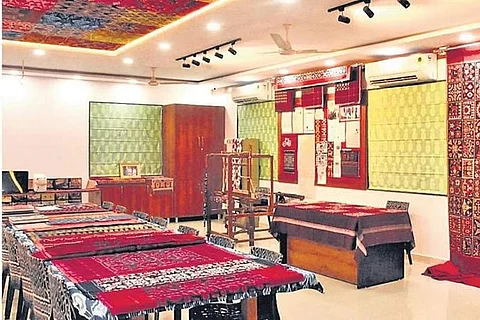

“So you picked #32. This 12x12 feet terracotta and black ikat exhibit with 100 motifs is the showstopper of the gallery. Ranging from religious symbols such as Om and Swastik to animals and an analog clock, the motifs are intricately woven on a robust cotton fabric,” he says, adding that it is a replica of the one that is on display at the Victoria and Alberta Museum in London. Govardhana, along with eight weavers, wove it about 23 years ago.

Starting January 14, the 1,000 sqft arty space has also begun regaling visitors with stories about heritage handloom weaves such as Gollabhama, Gadwal, Narayanpet and Pochampalli from Telangana with an hour-long documentary, focusing on heirloom techniques, stories and processes involved in their making.
Named after telia rumal, a weave Govardhana’s family pursued as a profession, the gallery boasts a collection of over 170 stunning pieces—from scarves to saris and textile pieces—with rare and quirky motifs. “I have collected these in the last 50-odd years. Some of them go back 200 years,” he says. What would a collector’s piece like this cost? “I will not sell anything from this collection. It is preserved for posterity,” says the 73-year-old, an authority in making traditional telia rumal in tie and dye technique.
“Telia rumal means an oiled cloth in Arabic. It is a backbreaking process in which cotton thread is soaked in fresh cattle dung overnight and then rinsed by dunking it in gingelly oil mixed with burnt castor kernels. It is then laid out to dry. The process is repeated for 21 days until the thread is as smooth as oil and then used to weave this double ikat technique,” the master weaver explains. This heritage weave is known to keep one’s head cool (due to oil absorption) and hence was patronised by the Nizams as royal head gears.
Hailing from Puttapaka, a weaving hamlet in Nalgonda in Telangana, Govardhana has been intertwined with the warps and wefts of this double ikat textile since he was a teenager. Thanks to his sound business acumen, the weaver diversified the family product range in the late 70s to introduce bedspreads, tablecloths, table runners, etc. By the mid-80s, the demand spiked and he was providing enough work for 500 looms in 20 villages in Nalgonda.
An instrumental figure in getting the weave a GI Certification in May 2020 and hailed as the father of telia rumal by the weavers’ community, it took Govardhana 40 years “to put together this dream”. The gallery also boasts over 200 rare books on the weave, including about 50 spiral-bound books which document the forgotten techniques enthusiastic local weavers had experimented with.